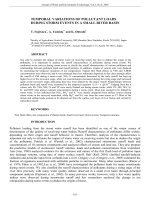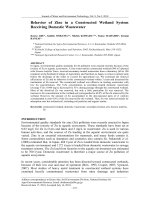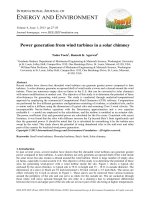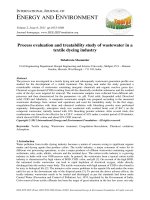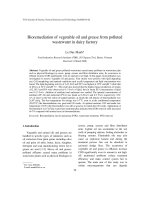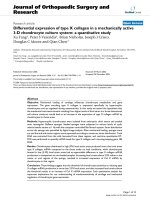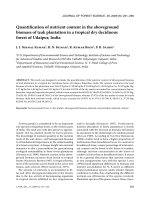Kinetics of pollutant removal from domestic wastewater in a tropical horizontal subsurface flow constructed wetland system effects of hydraulic loading rate
Bạn đang xem bản rút gọn của tài liệu. Xem và tải ngay bản đầy đủ của tài liệu tại đây (543.48 KB, 9 trang )
Ecological Engineering 36 (2010) 527–535
Contents lists available at ScienceDirect
Ecological Engineering
journal homepage: www.elsevier.com/locate/ecoleng
Kinetics of pollutant removal from domestic wastewater in a tropical horizontal
subsurface flow constructed wetland system: Effects of hydraulic loading rate
Ngo Thuy Diem Trang a,∗ , Dennis Konnerup b , Hans-Henrik Schierup b , Nguyen Huu Chiem a ,
Le Anh Tuan c , Hans Brix b
Department of Environmental Science, College of Environment and Natural Resources, Can Tho University, Campus I, 3/2 Street, Ninh Kieu District, Can Tho City, Vietnam
Department of Biological Sciences, Aarhus University, Ole Worms Allé 1, DK-8000 Århus C., Denmark
Department of Environmental and Natural Resources Management, College of Environment and Natural Resources, Can Tho University, Campus I, 3/2 Street, Ninh Kieu District,
Can Tho City, Vietnam
a
b
c
a r t i c l e
i n f o
Article history:
Received 25 July 2009
Received in revised form 5 November 2009
Accepted 23 November 2009
Keywords:
Ammonium
Background concentration
BOD
COD
First-order kinetics
Nitrogen
Phosphorus
Phragmites vallatoria
a b s t r a c t
The treatment capacity of constructed wetlands is expected to be high in tropical areas because of the
warm temperatures and the associated higher rates of microbial activity. A pilot scale horizontal subsurface flow constructed wetland system filled with river sand and planted with Phragmites vallatoria (L.)
Veldkamp was set up in the southern part of Vietnam to assess the treatment capacity and the removal rate
kinetics under tropical conditions. The system received municipal wastewater at four hydraulic loading
rates (HLRs) of 31, 62, 104 and 146 mm day−1 . Removals of TSS, BOD5 and COD were efficient at all HLRs
with mean removal rates of 86–95%, 65–83% and 57–84%, respectively. Removals of N and P decreased
with HLRs and were: NH4 -N 0–91%; TN 16–84% and TP 72–99%. First-order area-based removal rate
constants (k, m year−1 ) estimated from sampling along the length of the wetland from inlet to outlet at
the four HLRs were in the range of 25–95 (BOD5 ), 22–30 (COD), 31–115 (TSS), 5–24 (TN and TKN) and
41–84 (TP) at background concentrations (C*) of 5, 10, 0, 1.5 and 0 mg L−1 , respectively. The estimated
k-values should not be used for design purposes, as site-specific differences and stochastic variability can
be high. However, the study shows that domestic wastewater can be treated in horizontal subsurface
flow constructed wetland systems to meet even the most stringent Vietnamese standards for discharge
into surface waters.
© 2009 Elsevier B.V. All rights reserved.
1. Introduction
The treatment of domestic wastewater is far from satisfactory
in many subtropical and tropical countries, including Vietnam.
As opposed to Europe and North America, where nearly all
wastewater is collected in sewer systems and treated in large
centralized wastewater treatment facilities, in most other parts of
the world, centralized sewer systems and wastewater treatment
plants only exist in larger cities, whereas small and medium-sized
towns generally discharge wastewater untreated into the environment. Hence, for hygienic and environmental reasons, there is an
urgent need to implement appropriate wastewater management
systems in these areas, as for example constructed wetland (CW)
systems, that are low-cost, easy-to-operate, efficient and robust
(Denny, 1997; Haberl, 1999; Kivaisi, 2001). The CWs are currently
∗ Corresponding author. Tel.: +84 7103 830 635; fax: +84 7103 730 392.
E-mail address: (N.T.D. Trang).
0925-8574/$ – see front matter © 2009 Elsevier B.V. All rights reserved.
doi:10.1016/j.ecoleng.2009.11.022
being studied as a technology that can be used for the treatment
of many types of wastewater in tropical countries, including highstrength wastewater from agricultural activities and municipal
wastewater from small communities (Nahlik and Mitsch, 2006;
Bojcevska and Tonderski, 2007; Brix et al., 2007a; Konnerup et al.,
2009; Kantawanichkul et al., 2009). Treatment of wastewater in
CW systems is based on natural processes, and CWs can tolerate
a high variability in loading rate and wastewater quality. Furthermore, in addition to treating the wastewater, CW systems planted
with ornamental plants can provide a nice-looking environment
(Brix et al., 2007a; Zurita et al., 2009).
Horizontal subsurface flow CWs are commonly used for secondary and post-treatment of domestic wastewater in temperate
regions, and are efficient in solids and organic matter removal but
less efficient in nutrient removal (Masi and Martinuzzi, 2007; El
Hamouri et al., 2007; Brix et al., 2007b; Vymazal, 2009). Most
performance data available for CW systems are from temperate
climates, but the treatment performance is expected to be significantly higher in tropical areas because of the high temperatures and
the associated higher microbial activity. The area-specific removal
528
N.T.D. Trang et al. / Ecological Engineering 36 (2010) 527–535
capacity of pollutants in CWs is often evaluated using a firstorder reaction kinetics model (Kadlec and Knight, 1996; Kadlec,
2009). Removal rate constants (k) are often estimated based on
inlet–outlet performance data from operational CW systems (e.g.
Kadlec, 2009) and may therefore be affected by many factors,
such as wetland configuration, hydraulic loading characteristics,
hydraulic efficiency, and input pollutant concentration. Another
approach to estimate removal rate constants that is less affected
by some of these factors is to explore the concentration profiles of
the pollutants from inlet to outlet in the wetland and to use these
profiles to estimate removal rate constants (Kadlec, 2003).
The aim of the present study was to estimate the removal
capacity of horizontal subsurface flow CW systems under tropical conditions. We used an existing experimental CW system at
Can Tho University, Vietnam, that had been loaded with municipal wastewater at a hydraulic loading rate of 31 mm day−1 since
2003 with consistent efficient removals of suspended solids, BOD5 ,
COD, as well as nitrogen and phosphorus. The experimental system was equipped with facilities to sample water internal in the
system at different positions along the flow path from inlet to outlet. The system was run at four hydraulic loading rates, and the
first-order area-based removal rate constants (k) were estimated
based on the pollutant concentration profiles within the system.
It is to our knowledge the first time that this procedure has been
used in tropical climates to estimate removal kinetics in horizontal
subsurface flow CWs.
2. Materials and methods
2.1. Experimental setup
An experimental constructed wetland (CW) system with horizontal subsurface flow (HSF) was built at Can Tho University,
Vietnam (10◦ 00′ N, 105◦ 46′ E), in 2003 (Figs. 1 and 2). The CW
received a mixture of domestic sanitary wastewater, grey water
from dormitories and storm water collected in the sewer system
of the campus. The CW system contained a 6.4 m3 storage tank
into which the wastewater from the sewer system was pumped,
a 0.96 m3 pretreatment section, a 21.1 m3 wetland filter planted
with Phragmites vallatoria (L.) Veldkamp, and finally a 3 m3 effluent section. The first part of the pretreatment section was filled
with charcoal placed under a layer of ∅ 40–60 mm gravel for
deodorization and followed by a coconut fiber filter. The wetland filter (12 m × 1.6 m × 1.1 m; length × width × depth) was filled
with 0.25–0.43 mm (D10 –D60 ) river sand with a saturated hydraulic
conductivity of 9.8 m d−1 . Five sampling pipes were placed at the
bottom of the bed at different distances from the inlet for water
sampling (Fig. 2). Effluent from the wetland filter passed a gravelfilled (∅ 10–20 mm) effluent section where the outlet water level
was controlled by a tiltable vertical pipe.
Prior to the present experiment, the operation of the system was
stopped for 6 months and the system renovated. The sand at the
front 2 m of the wetland filter was washed, and P. vallatoria was
subsequently replanted at a density of 25 stems m−2 using 60 cm
cut culms from a nearby natural reed bed. Then the bed was saturated with wastewater and the plants allowed establishing for a
4-week period prior to continuous wastewater loading.
2.2. Wastewater loadings and samplings
From November 2007 to April 2008 four hydraulic loading rates
(HLRs) of 31, 62, 104 and 146 mm day−1 were applied to the CW system, each for a period of about 40 days starting with the lowest HLR.
The loading rates were controlled by filling the inlet storage tank
twice or three times daily with the desired amount of wastewater
from the sewer system using a manually controlled pump. From the
storage tank the wastewater was drained slowly into the system
through two valves to achieve even loading over time. The outlet
level was set just below the bed surface to secure water saturated
conditions in the wetland filter.
At each HLR, water samples were collected during the last 8 days
of the loading period when performance were assumed to be representative for the particular HLR. Grab samples were taken in the
morning every second day at the inlet (WL1), after the pretreatment unit (WL2), at the outlet (WL8), and at different intermediate
positions in the wetland filter (WL3 to WL7) corresponding to distances from the inlet of 1.9, 3.8, 5.9, 7.9 and 9.9 m using a perforated
plastic pipe to withdraw water from the sand bed (Fig. 2). All samples were collected and stored at 4 ◦ C in 2 L plastic bottles until
analysis in the laboratory.
2.3. Water quality analyses
The pH, dissolved oxygen (DO), temperature and electric conductivity (EC) of the water samples were analyzed on-site using
portable pH, DO and EC meters (HI 8424 and HI 9146, Hanna Instruments, Romania; Orion 011510, Thermo Electron Corporation,
USA). Total suspended solids (TSS) were analyzed by the filtration
method using Whatman GF/F filters. Ammonium nitrogen (NH4 N) and orthophosphate (PO4 -P) were analyzed in filtered samples
using the salicylate method (modified from Lachat, Quikchem No.
10-107-06-3-A or B), and standard colorimetric methods (APHA,
1998), respectively. Total phosphorus (TP) was analyzed by the
ascorbic acid method after acid hydrolysis in an autoclave for
30 min (APHA, 1998). Total Kjeldahl nitrogen (TKN) was analyzed at
HLRs of 104 and 146 mm day−1 using a Kjeldahl block digestion unit
(Kjeldatherm KB 20S, Gerhardt, Germany) and a semi-automatic
steam distillation unit (Vapodest 20, Gerhardt, Germany), and
total nitrogen (TN) was analyzed at HLRs of 31 and 62 mm day−1
using addition of Devarda’s alloy during distillation. For technical
reasons, we could not analyze nitrate nitrogen (NO3 − ), but later
analyses of the wastewater in the sewer system and the outlet of
the bed indicate that the concentrations were low (<2 mg L−1 at
a HLR of 31 mm day−1 and <4 mg L−1 at a HLR of 62 mm day−1 ).
Chemical oxygen demand (COD) was analyzed using a COD reactor at 150 ◦ C for 2 h (HACH Instruments, USA) and titration of
unreduced K2 Cr2 O7 with ferrous ammonium sulfate. Biochemical oxygen demand (BOD5 ) was analyzed by the OxyTop method
(TS606-G/2-i, Taiwan).
2.4. First-order modeling
First-order area-based removal rate constants (k), assuming
exponential removal to non-zero background wetland concentrations (C*), were estimated for TSS, BOD5 , COD, TN (or TKN) and TP.
Fitted values of k were derived from the following plug-flow k–C*
model (Kadlec and Knight, 1996):
ln
ky
Co − C∗
=−
Ci − C∗
q
where k is the first-order area-based removal rate constant
(m year−1 ), Co is the outlet concentration (mg L−1 ), Ci is the inlet
concentration (mg L−1 ), C* is the irreducible background wetland
concentration (mg L−1 ), q is the hydraulic loading rate (m year−1 )
and y is the fractional distance from inlet to outlet. The equation
was rearranged to carry out the fitting procedure:
Co = C ∗ +(Ci − C∗)exp−ky/q
N.T.D. Trang et al. / Ecological Engineering 36 (2010) 527–535
529
Fig. 1. Schematic profile diagram of the pilot scale horizontal subsurface flow constructed wetland.
Fittings were carried out using the non-linear regression procedure of the software Statgraphics Centurion XV (StatPoint, Inc.,
USA) with Ci and k as unknown parameters. Based on the lowest BOD5 concentrations (4.5 mg L−1 ) in the data set obtained in
this study, a constant C* of 5 mg L−1 for BOD5 was used in the
model. This C* value for BOD5 is also suggested by Kadlec (2009)
for HSF wetlands with inlet BOD5 concentrations in the range
of 30–100 mg L−1 . Typical C* background concentrations of 10, 0,
1.5, and 0 mg L−1 for COD, TSS, TN (or TKN) and TP, respectively,
were assumed and applied in the model because the outlet concentrations in the present study were far from the expected C*
concentrations (Kadlec and Knight, 1996).
2.5. Statistical analysis
All variables were tested for normal distribution and variance
homogeneity (Levene’s test) and logarithmically transformed if
necessary using Statgraphics Centurion XV (StatPoint, Inc., USA).
Comparisons of inlet and outlet concentrations and removal effi-
ciencies between the four HLRs were performed using one-way
analysis of variance (ANOVA). Two-way ANOVA using Type III sum
of squares was used to analyze the effect of HLR and distances
(positions along the CW system) on water quality. Post hoc comparisons using Tukey’s Honestly Significant Differences (HSD) were
used to identify significant differences between means at the 5%
probability level.
3. Results
3.1. Inlet and outlet water quality
The influent wastewater had concentration levels of nutrients corresponding to typical municipal wastewater (Bayley et
al., 2003), but was more dilute concerning TSS, BOD and COD.
Dissolved oxygen concentrations were low in the inlet and all
samples taken within the system (<1.6 mg L−1 ) and slightly higher
in the outlet (1.7–2.9 mg L−1 ), particularly at the highest HLR of
146 mm day−1 , and the water temperature varied between 26 ◦ C at
a HLR of 62 mm day−1 and 29 ◦ C at a HLR of 146 mm day−1 (data
Fig. 2. Longitudinal top view of the pilot scale horizontal subsurface flow constructed wetland.
530
N.T.D. Trang et al. / Ecological Engineering 36 (2010) 527–535
Fig. 3. Mean (±SD, n = 5) outlet (a) pH, and outlet concentration of (b) TSS, (c) COD and (d) BOD5 from the constructed wetland at different hydraulic loading rates. The
horizontal bars above the columns show the mean inlet concentrations.
Fig. 4. Mean (±SD, n = 5) outlet concentration of (a) TN or TKN, (b) NH4 -N, (c) TP and (d) PO4 -P from the constructed wetland at different hydraulic loading rates. The
horizontal bars above the columns show the mean inlet concentrations.
N.T.D. Trang et al. / Ecological Engineering 36 (2010) 527–535
531
Table 1
Mean (±1 SD, n = 5) pollutant removal efficiencies (%) at the four hydraulic loading rates of 31, 62, 104 and 146 mm day−1 and
results of one-way ANOVA statistic (F-ratio).
F-ratio
Hydraulic loading rate
−1
31 (mm day
BOD5
COD
TSS
TN or TKN
NH4 -N
TP
PO4 -P
83
84
93
84
91
99
99
±
±
±
±
±
±
±
6b
3c
2ab
3c
3c
1c
1b
)
−1
62 (mm day
65
68
94
61
69
98
99
±
±
±
±
±
±
±
)
7a
3b
1b
3b
13b
1c
1b
−1
104 (mm day
81
57
95
62
65
85
96
±
±
±
±
±
±
±
)
5b
10a
1b
7b
4b
5b
2b
−1
146 (mm day
)
76 ± 2b
63 ± 3ab
86 ± 5a
16 ± 9a
−1.4a
72 ± 6a
75 ± 6a
11.07***
20.33***
6.66*
106.68***
64.12***
48.88***
73.54***
Different superscript letters within rows indicate significant differences based on a Tukey HSD test (p < 0.05).
Data are for TN at hydraulic loading rates of 31 and 62 mm day−1 and TKN at hydraulic loading rates of 104 and 146 mm day−1 .
*
p < 0.05.
***
p < 0.001.
not shown). The composition of the wastewater varied over time
and the mean inlet concentration differed significantly (p < 0.01)
between the four experimental HLRs, except for TSS and total nitrogen (Figs. 3 and 4). The pH of the inlet was 7.5–7.8, and decreased
to 6.9–7.2 in the outlet (Fig. 3a). Mean inlet concentrations of TSS
were low (33–36 mg L−1 ) and decreased to <5 mg L−1 in the outlets (Fig. 3b). Mean inlet concentrations of COD varied between
124 and 169 mg L−1 and decreased to 23–63 mg L−1 in the effluent (Fig. 3c). Mean inlet concentrations of BOD5 varied between 40
and 80 mg L−1 and decreased to 16–21 mg L−1 in the outlet (Fig. 3d).
BOD5 mass loading rates were 25, 25, 46 and 72 kg ha−1 d−1 at the
HLRs of 31, 62, 104 and 146 mm day−1 , respectively. The concentrations of the different forms of N and P in the influent water
also differed significantly between the experimental loading periods (Fig. 4). Corresponding outlet concentrations of total N and
NH4 -N increased significantly with HLR, and at the highest HLR of
146 mm day−1 the outlet concentrations were just slightly lower,
or at the same level, as in the inlet (Fig. 4a and b). Outlet concentrations of P were consistently low (<0.2 mg L−1 ) at the two lowest
HLRs, but the concentrations of total P and PO4 -P increased to 3.0
and 3.1 mg L−1 , respectively, at the highest HLR of 146 mm day−1
(Fig. 4c and d).
3.2. Removal efficiencies
The removal efficiencies of the pollutants calculated as the
percent change in concentrations from inlet to outlet decreased
significantly with HLR (Table 1). Particularly at the highest HLR
of 146 mm day−1 , the removal percentages were low because
some overland flow occurred in the planted bed, despite the
fact that the outlet pipe controlling the water level was set low.
For COD and BOD5 the removal rates ranged between 57% and
84%, and were lowest for BOD5 at 62 mm day−1 probably because
inlet BOD5 concentrations were relatively low at this HLR. TSS
was removed effectively (>93%) at the three lowest HLRs, and
by 86% at the highest HLR (Table 1). Removal of TN and TKN
also decreased with loading rate to 16% at the highest HLR, and
removal of NH4 -N decreased 91% at a HLR of 31 mm day−1 to
no removal at a HLR of 146 mm day−1 . Removal efficiencies of
TP and PO4 -P were high at all four HLRs but decreased from
>98% at the two lowest HLRs to approximately 75% at the highest
HLR.
3.3. First-order reaction rate constants
The concentrations of pollutants generally decreased exponentially to non-zero plateaus along the flow path in the planted
bed, particularly BOD5 , COD, TSS and TP as shown in Fig. 5 for a
HLR of 62 mm day−1 . Nitrogen was removed less effectively and
did not approach the background plateau towards the outlet of
the system (Fig. 5d). We used the plug-flow k–C* model presented by Kadlec and Knight (1996) and constant background
concentrations (C*) to fit the exponential decrease in pollutant
concentration at each HLR, and the estimated first-order areabased removal rate constants (k) and coefficients of determination
(R2 ) for BOD5 , COD, TSS, TN (and TKN) and TP are presented in
Table 2. The model fitted well for all the measured parameters
except TN at the highest HLR of 146 mm day−1 (Table 2). The
estimated k-values of BOD5 were in the range of 25–95 m year−1
and highest at high HLR. Removal rate constants for COD were
lower, 22–30 m year−1 , and for TSS the removal constant was nearly
fourfold higher at a HLR of 131 mm day−1 compared to a HLR of
31 mm day−1 corresponding to the fourfold higher HLR. Estimated
k-values for TN (or TKN) and TP were variable, in the range of
5–24 and 41–84 m year−1 , respectively. Rate constants generally
increased slightly as HLRs increased for BOD5 and COD, but not for
TN and TP, where the estimated k-values were highest at a HLR of
62 mm day−1 .
Table 2
Estimated (±SE) first-order area-based removal rate constants (k) and coefficients
of determination (R2 ) for BOD5 , COD, TSS, TN (or TKN) and TP removal in the constructed wetlands based on the k–C* model at the four HLRs of 31, 62, 104 and
146 mm day−1 .
HLR (mm day−1 )
k (m year−1 )
BOD5
31
62
104
146
37
25
95
88
±
±
±
±
6
5
13
13
COD
31
62
104
146
21
30
23
30
±
±
±
±
2
2
3
5
TSS
31
62
104
146
31
51
82
115
±
±
±
±
4
6
10
20
TN
C* (mg L−1 )
R2
(5)
(5)
(5)
(5)
0.64
0.48
0.71
0.61
(10)
(10)
(10)
(10)
0.84
0.85
0.60
0.48
(0)
(0)
(0)
(0)
0.84
0.83
0.84
0.75
31
62
12 ± 1
24 ± 2
(1.5)
(1.5)
0.77
0.84
TKN
104
146
23 ± 3
5±3
(1.5)
(1.5)
0.66
0.07
TP
31
62
104
146
40
84
51
66
(0)
(0)
(0)
(0)
0.77
0.95
0.77
0.60
±
±
±
±
6
5
6
11
Constant background concentrations (C*) of 5, 10, 0, 1.5 and 0 mg L−1 for BOD5 , COD,
TSS, TN (or TKN) and TP, respectively, were used in the calculations.
532
N.T.D. Trang et al. / Ecological Engineering 36 (2010) 527–535
Fig. 5. The progression of (a) BOD5 , (b) COD, (c) TSS, (d) TN and (e) TP concentrations through the constructed wetland at HLR of 62 mm day−1 . Fitted curves based on the
first-order area-based k–C* model. Data points were five measurements in every hydraulic loading rate. A typical C* of 5, 10, 0, 1.5 and 0 for BOD5 , COD, TSS, TN and TP were
used to fit the model.
4. Discussion
This study for the first time presents first-order removal rate
constants estimated from the exponential decrease in pollutant
concentrations along the flow path from inlet to exit of a tropical horizontal subsurface flow CW system and at different HLRs.
The influent wastewater was rather dilute concerning TSS, BOD
and COD, which is commonly observed in many tropical areas,
where organic pollutants are degraded relatively fast in sewers and
canals as a consequence of the high temperatures. Also, in tropical
areas, where part or whole of the sewer system is open channels,
the composition of the wastewater varies over the year in concert
with the dry and rainy seasons. The concentrations of nutrients in
the wastewater corresponded, however, to levels in typical municipal wastewater. We suggest that the results obtained in this study
are representative for primary settled municipal sewage in tropical
areas.
The removals of TSS, BOD and COD were generally efficient and
decreased only slightly at the highest HLR where some overland
flow occurred. Suspended solids are mainly removed by physi-
cal mechanisms, such as sedimentation and filtration processes,
and most solids were removed within the pretreatment unit and
the first section of the planted bed. BOD and COD removal probably mainly occurred by anaerobic process as oxygen levels were
consistently low in the planted bed and as pH dropped during
passage through the bed. Old and decaying roots from previous
studies probably decomposed throughout the bed and may have
contributed to the relatively high background levels of BOD and
COD recorded in the present study.
Nitrogen removal in constructed wetlands occurs through
adsorption, assimilation into microbial and plant biomass, ammonia volatilization and coupled nitrification–denitrification, and so
depends much on the environment inside the system. Ammonia
volatilization was probably very low, as the pH was in the range of
6.9–7.4. The plant uptake was not quantified in the present study,
but as the Phragmites plants were planted only 1 month before
starting the study, plant uptake of N might have contributed to the
recorded nutrient removals, as have also been documented in other
studies (Koottatep and Polprasert, 1997; Greenway and Woolley,
2001; Kyambadde et al., 2005; Konnerup et al., 2009). However,
N.T.D. Trang et al. / Ecological Engineering 36 (2010) 527–535
the main removal process for N was probably denitrification, as
the nitrification process, which is a prerequisite for denitrification,
could occur in the upper layer of the sand bed and at oxic microsites
in the rhizosphere of Phragmites. At high HLR the outlet NH4 -N concentration was at the same level as in the influent, showing that
the capacity of the nitrification–denitrification process had been
exceeded.
The major processes responsible for P removal in horizontal subsurface flow constructed wetlands are adsorption to the
medium, precipitation and assimilation into microbial and plant
biomass. The initial years after construction of the CW system, the
removal rate of TP was very high, 92–98%, at a hydraulic loading of 31 mm day−1 with a slightly decreasing trend in removal
over time (L.A. Tuan, 2005, unpublished). Resting of the system
and the renovation prior to the present experiment probably
reconstituted the P adsorption capacity of the sand medium and
contributed to the very efficient P removal obtained, although
plant uptake of P might also have been important. The sand
medium used in the bed was river sand with an unknown chemical composition, but high contents of iron and/or calcium might
be responsible for the efficient P removal. Efficient adsorption of
P to the bed medium and associated high P removals have also
been reported by Kern and Idler (1999), but removals are likely
to decrease over time due to the saturation of P sorption sites in
the medium (Arias et al., 2001; Arias and Brix, 2005; Vohla et al.,
2007).
The HLR and the consequent detention time of the water are
important for the treatment processes in a CW system. At low HLR
the detention time is high, and at high HLRs the water passes rapidly
to the outlet reducing the contact time between the wastewater
and the microorganisms, that are responsible for the degradation
processes. The four applied HLRs (31, 62, 104 and 146 mm day−1 )
gave nominal detention time of 13.9, 6.9, 4.2 and 3 days, respectively, and thus result in up to fourfold differences in the duration
of contact between pollutants and microorganisms. The removal
percentage of nutrients was especially affected by the HLR, with
lower removals at high HLRs, while organic and solids removal
percentages were only slightly affected. This is agreement with
results from several other CW systems. Tanner et al. (1995a,b)
reported that, as the detention time increased from 2 to 7 days
in a subsurface flow gravel-bed system treating dairy wastewater in New Zealand, the mean removal of all analyzed pollutants
increased. Also, Huang et al. (2000) reported that NH4 -N and TKN
concentrations in a subsurface flow constructed wetland treating domestic wastewater decreased exponentially with increasing
detention times, and Chung et al. (2008) in a CW treating municipal sewage in Hong Kong found lower removal efficiencies for N
and P at 5 days detention time than at 10 days detention time,
but no difference in COD removal. The significantly poorer performance at a HLR of 146 mm day−1 in the present study therefore
can partly be explained by low detention time at this loading
rate, but hydraulic overloading leading to short circuiting of flow
between inlet and outlet probably also affected performance significantly.
First-order area-based removal rate constants (k) and apparent
background concentrations (C*) are commonly used in treatment
wetlands design (Kadlec, 2000) although recently the tanks-inseries model has been advocated to account for the imperfect flow
patterns that prevail in wetlands (Kadlec, 2009). The estimated
removal rate constants and apparent background concentrations
have been shown to depend strongly on input water quality as well
as hydraulic loading rates (Kadlec, 2000, 2003). Furthermore, the
constituents of lumped parameters such as BOD may be degraded
or removed at different rates within a CW system with corresponding differences in removal rate constants (Kadlec, 2003). In the
533
present study, we used the internal concentration profiles from
inlet to outlet of the CW system as the basis for estimating removal
rate constants. This procedure counteracts some of the problems
listed above and should therefore lead to more reliable estimates
of the rate constants.
The k–C* model used fitted the concentrations profiles quite
well for all parameters at HLRs up to 104 mm day−1 . At the highest
HLR of 146 mm day−1 the goodness of fit was poorer as indicated
by the lower coefficients of determination (R2 ). The estimated kvalues for BOD5 and COD removal differed between HLRs, but not
in a consistent manner, and were in the range of 25–95 m year−1 for
BOD and 22–30 m year−1 for COD, similar to the range reported for
many horizontal flow CWs (Kadlec and Knight, 1996; Rousseau et
al., 2004; Konnerup et al., 2009; Kadlec, 2009). The estimated rate
constants for TSS removal increased nearly fourfold in response to
the fourfold increase in HLR, showing that the k–C* model does
not adequately describe the TSS removal in the system. Most TSS
was removed at the front end of the system by filtration and sedimentation, and independently on HLR. First-order removal models
can therefore not be used to describe TSS removal in horizontal
subsurface flow CWs.
The estimated k-values for TN were in the range of
5–24 m year−1 which is higher than reported by Konnerup et al.
(2009), who found k-values for TN in the range of 3–6 m year−1
in tropical subsurface flow CWs treating domestic sewage. In vertical flow CWs treating high-strength synthetic wastewater at
HLRs between 20 and 80 mm day−1 in Thailand, Kantawanichkul
et al. (2009) found k-values for TKN 30 m year−1 . Median rate constants for TN in 136 free water surface wetlands are reported
to be 12.6 m year−1 and in 123 horizontal subsurface wetlands
8.4 m year−1 (Kadlec, 2009). However, as total N is a lumped
parameter consisting of a mixture of organic-N and different
inorganic ions such as NH4 -N and NO3 -N, removal of total N
can in principle not be modeled using a one component k–C*
model as in the present study. Rather, a sequential conversion
model that includes ammonification, nitrification and denitrification should be used to better describe removal (Kadlec,
2009).
The k-values for TP were very high, in the range of
41–84 m year−1 , which is very much higher than the 2–5 m year−1
found by Konnerup et al. (2009) and the 13.5 m year−1 reported by
Kantawanichkul et al. (2009). The median rate constant for TP in
282 free water surface flow wetlands is 10 m year−1 , and in 82 horizontal subsurface flow wetlands 6 m year−1 (Kadlec, 2009). The
main removal process for P at the high loading rates used in the
present study is adsorption and/or precipitation to the bed medium
(Brix et al., 2001; Del Bubba et al., 2003; Arias and Brix, 2005). The
sandy bed medium used in the experimental CW system thus had
a high P sorption capacity compared to the coarser media used in
other tropical studies (Konnerup et al., 2009; Kantawanichkul et
al., 2009). Further studies are however needed to clarify the longer
term performance as the sorption sites are likely to be saturated
over time (Brix et al., 2001).
The Vietnamese national standards (TCVN 5945-2005) set by
the Ministry of Science, Technology and Environment for effluent
discharged into water bodies from which domestic water is taken
are 30, 50 and 50 mg L−1 for BOD5 , COD and TSS, respectively, and
15 mg L−1 for TN, 5 mg L−1 for ammonia-N, and 4 mg L−1 for total
P. The discharge from the CW systems at the two lowest HLRs of
31 and 62 mm day−1 met these standards, except for ammoniaN and TN which were only slightly higher than the standards at
a HLR of 62 mm day−1 . The Vietnamese standards for discharge
into water bodies used for transportation, irrigation, fishing, or
bathing are less stringent, and actually the effluent from the CW
system met these standards at all HLRs. Constructed wetland sys-
534
N.T.D. Trang et al. / Ecological Engineering 36 (2010) 527–535
tems with horizontal subsurface flow thus are a suitable technology
to treat domestic wastewater in Vietnam, and at HLR up to approximately 50 mm day−1 (equivalent to 50 L m−2 ), CW systems of the
type studied here will meet even the strictest Vietnamese effluent
standard.
5. Conclusions
The results of this study document that domestic wastewater
can be treated in horizontal subsurface flow constructed wetland
systems to meet even the most stringent Vietnamese standards for
discharge into surface waters. Under tropical climatic conditions,
the area-based removal rate constants seem to be significantly
higher than previously reported for CW systems in temperate
areas, and the higher water temperatures are the most plausible
explanation. We estimated removal rate constants based on pollutant concentration profiles from inlet to outlet as this procedure
is more robust in relation to variations in hydraulic loading rate
and wastewater composition. However, the estimated k-values
should not be used for design purposes, as site-specific differences and stochastic variability can be high because of factors
such as weather, plant growth, and unpredictable fluctuations
in input water quality and flow. The river sand used as growth
substrate in the planted bed had excellent P-removal properties, but the chemical characteristics of the sand has not yet
been studied and the long-term performance is not known. The
present study documents that constructed wetland systems do
perform very well in a tropical setting, and we hope that the
promising results will contribute to stimulate to a broader use
of CW systems as a robust, reliant, cost-effective and efficient
wastewater management systems in Vietnam and other tropical
countries.
Acknowledgements
Funding for this project came from the Danish International Development Agency (DANIDA) through the Can Tho
University–University of Aarhus Link in Environmental Science
(CAULES) project.
References
APHA, 1998. Standard Methods for the Examination of Water and Wastewater, 20th
ed. American Public Health Association, Washington, DC.
Arias, C.A., Brix, H., 2005. Phosphorus removal in constructed wetlands: can suitable
alternative media be identified? Water Sci. Technol. 51 (9), 267–273.
Arias, C.A., Del Bubba, M., Brix, H., 2001. Phosphorus removal by sands for use as
media in subsurface flow constructed reed beds. Water Res. 35 (5), 1159–1168.
Bayley, M.L., Davison, L., Headley, T.R., 2003. Nitrogen removal from domestic effluent using subsurface flow constructed wetlands: influence of depth, hydraulic
residence time and pre-nitrification. Water Sci. Technol. 48 (5), 175–182.
Bojcevska, H., Tonderski, K., 2007. Impact of loads, season, and plant species on the
performance of a tropical constructed wetland polishing effluent from sugar
factory stabilization ponds. Ecol. Eng. 29 (1), 66–76.
Brix, H., Arias, C.H., Del Bubba, M., 2001. Media selection for sustainable phosphorus removal in subsurface flow constructed wetlands. Water Sci. Technol. 44
(11–12), 47–54.
Brix, H., Koottatep, T., Laugesen, C.H., 2007a. Wastewater treatment in tsunami
affected areas of Thailand by constructed wetlands. Water Sci. Technol. 56 (3),
69–74.
Brix, H., Schierup, H.-H., Arias, C.A., 2007b. Twenty years experience with constructed wetland systems in Denmark: what did we learn? Water Sci. Technol.
56 (3), 63–68.
Chung, A.K.C., Wu, Y., Tam, N.F.Y., Wong, M.H., 2008. Nitrogen and phosphate
mass balance in a sub-surface flow constructed wetland for treating municipal
wastewater. Ecol. Eng. 32 (1), 81–89.
Del Bubba, M., Arias, C.A., Brix, H., 2003. Phosphorus absorption maximum of sands
for use as media in subsurface flow constructed reed beds as measured by the
Langmuir isotherm. Water Res. 37 (14), 3390–3400.
Denny, P., 1997. Implementation of constructed wetlands in developing countries.
Water Sci. Technol. 35 (5), 27–34.
El Hamouri, B., Nazih, J., Lahjouj, J., 2007. Subsurface-horizontal flow constructed
wetland for sewage treatment under Moroccan climate conditions. Desalination
215 (1–3), 153–158.
Greenway, M., Woolley, A., 2001. Changes in plant biomass and nutrient removal
over 3 years in a constructed wetland in Cairns, Australia. Water Sci. Technol.
44 (11–12), 303–310.
Haberl, R., 1999. Constructed wetlands: a chance to solve wastewater problems in
developing countries. Water Sci. Technol. 40 (3), 11–17.
Huang, J., Reneau Jr., R.B., Hagedorn, C., 2000. Nitrogen removal in constructed wetlands employed to treat domestic wastewater. Water Res. 34 (9), 2582–2588.
Kadlec, R.H., 2000. The inadequacy of first-order treatment wetland models. Ecol.
Eng. 15 (1–2), 105–119.
Kadlec, R.H., 2003. Effects of pollutant speciation in treatment wetlands design. Ecol.
Eng. 20 (1), 1–16.
Kadlec, R.H., 2009. Comparison of free water and horizontal subsurface treatment
wetlands. Ecol. Eng. 35 (2), 159–174.
Kadlec, R.H., Knight, R.L., 1996. Treatment Wetlands. Lewis Publishers, CRC Press
Inc., Boca Raton, FL.
Kantawanichkul, S., Kladprasert, S., Brix, H., 2009. Treatment of high-strength
wastewater in tropical vertical flow constructed wetlands planted with Typha
angustifolia and Cyperus involucratus. Ecol. Eng. 35 (2), 238–247.
Kern, J., Idler, C., 1999. Treatment of domestic and agricultural wastewater by reed
bed systems. Ecol. Eng. 12 (1–2), 13–25.
Kivaisi, A.K., 2001. The potential for constructed wetlands for wastewater treatment
and reuse in developing countries: a review. Ecol. Eng. 16 (4), 545–560.
Konnerup, D., Koottatep, T., Brix, H., 2009. Treatment of domestic wastewater in
tropical, subsurface flow constructed wetlands planted with Canna and Heliconia. Ecol. Eng. 35 (2), 248–257.
Koottatep, T., Polprasert, C., 1997. Role of plant uptake on nitrogen removal in constructed wetlands located in the tropics. Water Sci. Technol. 36 (12), 1–8.
Kyambadde, J., Kansiime, F., Dalhammar, G., 2005. Nitrogen and phosphorus removal
in substrate-free pilot constructed wetlands with horizontal surface flow in
Uganda. Water Air Soil Pollut. 165 (1–4), 37–59.
Masi, F., Martinuzzi, N., 2007. Constructed wetlands for the Mediterranean countries: hybrid systems for water reuse and sustainable sanitation. Desalination
215 (1–3), 44–55.
Nahlik, A.M., Mitsch, W.J., 2006. Tropical treatment wetlands dominated by freefloating macrophytes for water quality improvement in Costa Rica. Ecol. Eng. 28
(3), 246–257.
Rousseau, D.P.L., Vanrolleghem, P.A., De Pauw, N., 2004. Constructed wetlands in
Flanders: a performance analysis. Ecol. Eng. 23 (3), 151–163.
Tanner, C.C., Clayton, J.S., Upsdell, M.P., 1995a. Effect of loading rate and planting
on treatment of dairy farm wastewaters in constructed wetlands-I. Removal
of oxygen demand, suspended solids and faecal coliforms. Water Res. 29 (1),
17–26.
Tanner, C.C., Clayton, J.S., Upsdell, M.P., 1995b. Effect of loading rate and planting
on treatment of dairy farm wastewaters in constructed wetlands-II. Removal of
nitrogen and phosphorus. Water Res. 29 (1), 27–34.
Vohla, C., Alas, R., Nurk, K., Baatz, S., Mander, U., 2007. Dynamics of phosphorus,
nitrogen and carbon removal in a horizontal subsurface flow constructed wetland. Sci. Total Environ. 380 (1–3), 66–74.
Vymazal, J., 2009. The use constructed wetlands with horizontal sub-surface flow
for various types of wastewater. Ecol. Eng. 35 (1), 1–17.
Zurita, F., De Anda, J., Belmont, M.A., 2009. Treatment of domestic wastewater and
production of commercial flowers in vertical and horizontal subsurface-flow
constructed wetlands. Ecol. Eng. 35 (5), 861–869.
Ngo Thuy Diem Trang (born 1976, Vietnam) got her M.Sc.
in 2004 from the University of Putra Malaysia, Malaysia.
She is currently carrying out her Ph.D. at the Department of Environmental Sciences, College of Environment
and Natural Resources, Can Tho University (Vietnam) and
Aarhus University (Denmark), under the supervision of
Drs. Hans Brix, Hans-Henrik Schierup and Nguyen Huu
Chiem. The topic of her studies is the use of constructed
wetlands in pollution control, particularly in recirculating
aquaculture systems.
Dennis Konnerup is carrying out his Ph.D. study at Aarhus
University, Denmark. The topic of his Ph.D. work is the
ecophysiology of wetland plants and the use of constructed wetlands for the treatment of wastewater, with
particular focus on wetlands in tropical areas.
N.T.D. Trang et al. / Ecological Engineering 36 (2010) 527–535
535
Hans-Henrik Schierup is an emeritus professor in the
Department of Biological Sciences, Aarhus University
(Denmark). He is specialised in limnology and ecophysiology of wetland plants.
Le Anh Tuan is a senior lecturer in the Department of Environment and Natural Resources Management, College of
Environment and Natural Resources, Can Tho University,
Vietnam. He got his Ph.D. in Hydrological Environment in
Belgium in 2008. He is interested in the design of constructed wetlands, wetland ecology and climate change.
Nguyen Huu Chiem is the head of the Department of Environmental Sciences, Vice Dean College of Environment
and Natural Resources, Can Tho University, Can Tho City,
Vietnam. He is specialised in soil science, social-economic
and wetland ecology and management in the Mekong
Delta.
Hans Brix is a professor in the Department of Biological
Sciences, Aarhus University (Denmark). He is specialised
in ecophysiology of wetland plants and use of wetlands in
water pollution control.

